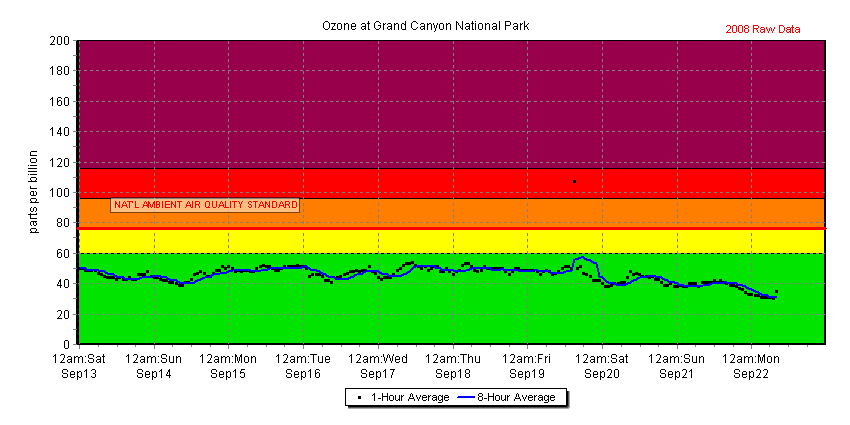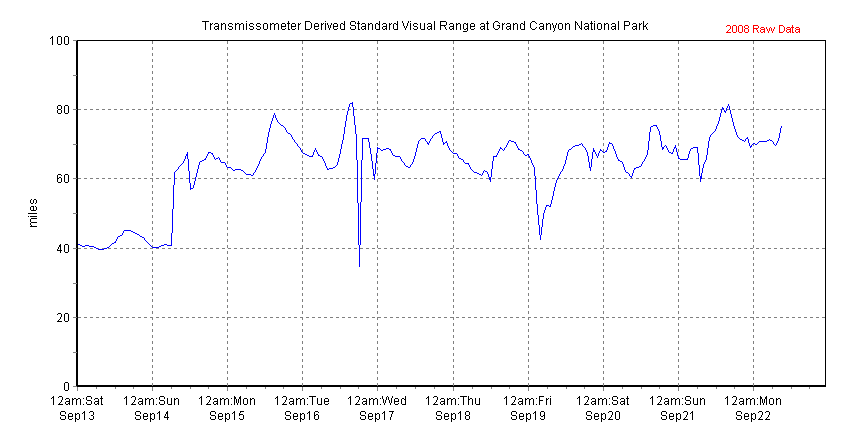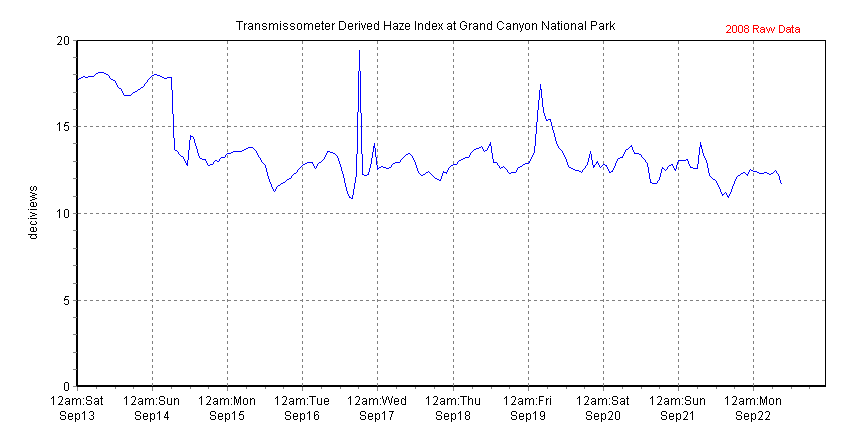Grand Canyon National Park Data Timelines
Ozone Data Collected at The Abyss Monitoring Site and
Visibility Data Collected at the Yavapai Museum Transmissometer Monitoring Site
Ozone -- 1-hour and 8-hour average concentrations

The background of the chart is color coded and relates to the EPA National Ambient Air Quality Standard for ozone, which is designed to protect human health. The chart plots both the 1-hour and running 8-hour average ozone concentration, but only the 8-hour average should be used to compare with the standard. The standard is exceeded when the 8-hour concentrations reach or go above 76 parts per billion, as denoted by the line with the label NAT'L AMBIENT AIR QUALITY STANDARD. Compare the background color behind the data concentration values with the colors in the table below to determine the levels of health concern and caution associated with that concentration.
| Good | No cautionary statement. |
| Moderate | Unusually sensitive people should consider reducing prolonged or heavy exertion outdoors. |
| Unhealthy For Sensitive People | Active children and adults, and people with lung disease, such as asthma, should reduce prolonged or heavy exertion outdoors. |
| Unhealthy | Active children and adults, and people with lung disease, such as asthma, should avoid prolonged or heavy exertion outdoors. Everyone else, especially children, should reduce prolonged or heavy exertion outdoors. |
| Very Unhealthy | Active children and adults, and people with lung disease, such as asthma, should avoid all outdoor exertion. Everyone else, especially children, should avoid prolonged or heavy exertion outdoors. |
Visibility -- Standard Visual Range

Particulate matter and gaseous air pollution affects visibility to some degree in every national park. Air pollution can create a white or brown haze that affects not only how far we can see but how well we are able to see the colors, forms, and textures of a scenic vista. The pollution causing this haze is often carried by the wind hundreds of miles from where it originated.
Visual range is one measure of visibility and is defined as the greatest distance at which a large black object can be seen and recognized against the background sky. It is not directly measured but rather calculated from a measurement of light extinction which includes the scattering and absorption of light by particles and gases. (These terms are explained in an Introduction to Visibility.) Extinction depends on the mass and chemical composition of the particles and gases and is a quantitative measure of how the passage of light from a scenic feature to an observer is affected by air pollutants. Extinction is monitored with transmissometers or nephelometers, or reconstructed from measurements of particle mass and chemical composition.
The larger the visual range the better the visibility. Average annual visual range in 2004 ranged from 30 to 75 miles in the eastern U.S. and 90 to 140 miles in the western U.S..
Visibility -- Haze Index

Haze Index, expressed in deciviews (dv), is also derived from light extinction measurements, and is designed in such a way that changes in it is linear with changes in human visual perception, similar to decibels. Unlike visual range, the deciview scale is near zero for a pristine clean atmosphere and increases as visibility is degraded.